Howard Phillips Lovecraft or H. P. Lovecraft is probably my favorite horror writer of all time.
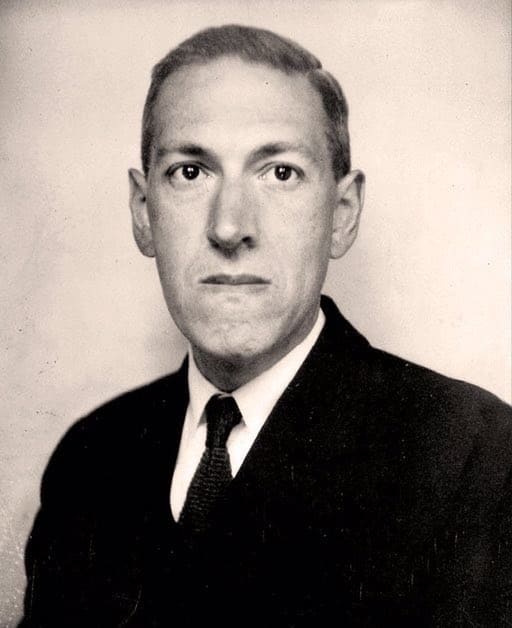
There’s something about his style, the scope of his works, and of course his many creations that make the man’s work so fascinating to me.
Not to mention cosmic horror itself, which has become my favorite sub-genre of horror.
Are you looking for more horror recommendations? Check out my list on the most terrifying tales by Edgar Allan Poe, or my list of the best horror books.
Discovering Lovecraft
Yet Lovecraft was a name I learned of relatively late.
I grew up with the works of Stephen King, having read the Dark Tower and some of his other works as a teenager. There were many other horror writers I knew via pop-culture references or from friends and family, like Edgar Allan Poe, Clive Barker, Neil Gaiman, Bram Stoker, or Anne Rice.
Somehow, though, Lovecraft was a name I never heard of during that time. I guess he might not have been too popular in my native country of Germany.
I even watched many of the movies that were based on or inspired by his works, oblivious to the stories themselves.
It was during my time at university, in the mid-2000s, that I first heard his name. At the time, I frequently listened to audiobooks. One I came upon was about Lovecraft and featured an abridged version of the Call of Cthulhu. I remember little about it anymore, and for a few more years, Lovecraft should stay nothing but a random name to me.
It was only when I started to write horror and read the works of other fellow writers that Lovecraft’s influence and popularity became clear to me.
The moment I read up on horror literature, Lovecraft was a name that came up frequently. Even more so was the sub-genre of Lovecraftian Horror which you could seem to avoid. It wasn’t long before I was intrigued and drawn to it.
At first, I thought Lovecraftian Horror was merely a genre about eldritch abominations and indescribable horrors who preyed on mankind. Only when I started to read his works did I learned just how vast his themes truly were.
However, I’d only read two of his stories. One was Facts Concerning the Late Arthur Jermyn and His Family, the other was Dagon.
When I finally decided to do a deep-dive into his works, I was in for quite a surprise, a big one, and I loved everything about Lovecraft’s work.
Lovecraft’s Work
Lovecraft is most famous for creating Cthulhu and the Cthulhu Mythos. He’s the father of the Necronomicon, a big that’s appeared in countless movies, games, and other media. Other creations include Nyarlathotep, The Deep Ones, The Elder Things, The Mad Arab, The Old Ones, and The Elder Gods.
He has, however, written many more stories, many of those only vaguely or not related to the Cthulhu Mythos at all.
Lovecraft’s body can be divided into three phases. The first phase was his macabre or horror phase, mostly inspired by the works of Edgar Allan Poe. The second phase, the so-called Dream phase or his Dream Cycle, which were inspired by the writings of Lord Dunsany. And lastly, the works he’s most famous for, his cosmic horror tales related to the Cthulhu Mythos.
I’m personally not a fan of his Dream Cycle work. Many of them don’t seem like actual stories to me. Instead, they feel more akin to exercises in world-building and imagery. Even his longest Dream Cycle work, The Dream-Quest of Unknown Kadath seemed, at least to me, lackluster, strange and at times ridiculous. It was a colorful, creative, and weird story, but also one that was confusing and, most of all, bland. It was filled with beautiful imagery, but it felt less serious and a lot less refined than the works preceding and succeeding it.
I was most impressed with his last works. His blend of horror and science-fiction, two genres he fused into a weird whole that can only be described as Lovecraftian Horror. It’s a combination of supernatural terror inter-mixed with concepts of visionary science-fiction.
Lovecraft’s work is full of strange, beautiful ideas, weird images, and creativity much vaster than almost any other horror writer’s.
Before Lovecraft, horror consisted mostly of Poe-esque stories, ghost tales, and vampire novels.
Lovecraft expanded the scope of horror by shifting its focus from the more psychological horror of Poe, from the gothic horror to something grander. He’s nothing short of a horror fiction genius, one I might say was far ahead of his time. In a way, he’s the successor to Edgar Allan Poe and as influential as him in the entirety of the horror genre.
Stephen King once said that “[he was] the twentieth century’s greatest practitioner of the classic horror tale.” Few refute that claim.
Lovecraft’s work, especially his later stories related to the Cthulhu Mythos, are terrifying on a different level, a level that hadn’t been seen before. They go far beyond the scope of horror at the time. These stories didn’t just feature creatures stalking mankind or revengeful ghosts. They didn’t merely feature ghastly incidents. No, there was something so broad, so different to them.
It’s called cosmic horror.
Cosmic Horror
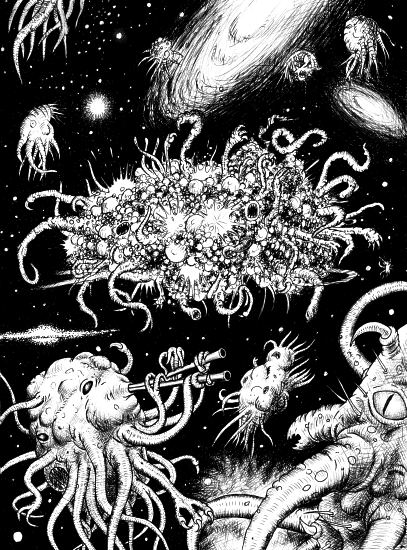
To bring forth this new sort of cosmic terror, Lovecraft included ancient civilizations, extraterrestrials, eldritch horror, occult lore far older than mankind itself, and even the entirety of the universe.
In many stories, the true horror isn’t the creatures his narrators encounter, but them having to face the triviality of not only their own existence but that of all of mankind. It’s the realization that there are creatures and entities out there, so old, so powerful and intelligent, that we, as humans, don’t even matter to them.
This bleak and unforgiving view is central to Lovecraft’s final and most famous phase.
Man is entirely insignificant, and he once stated:
“There are animals in the cosmos significantly more intelligent and effective than humankind.”
This fits well with another general theme of his work, one that has become central in cosmic horror as well. It’s the fear of the unknown. Lovecraft famously said:
“The oldest and strongest emotion of mankind is fear, and the oldest and strongest fear is fear of the unknown.”
It’s the idea that something unnamable, unspeakable, or indescribable is out there, something whose mere existence and knowledge might drive us insane.
That’s why Lovecraft so often writers about Elder Gods, entities far more hideous and different to anything we know or could even imagine.
And this, as well as his cosmic horror themes, is why so many of his characters succumb to insanity and give into madness.
For a contemporary take on cosmic horror and the fear of the unknown, I strongly recommend my list of the best horror manga, which includes works and writers heavily inspired by the Lovecraft’s themes.
Lovecraft’s Writing Style
Yet, Lovecraft’s writing can be dense, his style verbose, flowery, and at times even pompous and pretentious. It’s a style that’s rather antiquarian and even during his lifetime many people came to call it ‘old-fashioned.’
This use of language, however, helps to solidify his style. It helps to create an atmosphere that made his stories work so well. It helps to give them a pseudo-scientific feeling.
Even more so because his narrators are seldom normal, everyday people. They are often scholars, men of science, professors, or doctors whose thirst for knowledge drives them to discover a terrible truth.
Yet, his style might ultimately have been counterproductive and might have been the reason his work was unpopular with audiences.
We don’t know, however. His unpopularity might be attributed to the outlandishness of his ideas, his archaic style, or his personality, considering he was his own, harshest critic.
As influential as Lovecraft would one day become, he earned little from his writing and stayed, ultimately, almost completely unknown during his time.
In case you want to know more about Lovecraft’s life, I urge you to check out the Writers Mythos and their episode on Howard Phillips Lovecraft.
A List of the Best Lovecraft Stories
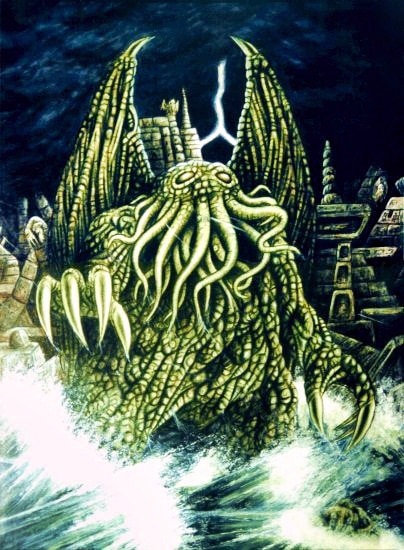
I said it before, Lovecraft’s work and style might take some getting used to. It took me a while as well. When I was used to it, however, I grew to passionately love his work.
That’s why I put together a list of the best Lovecraft stories.
I’m going to put up links to the electronic text for any of the stories featured at The H. P. Lovecraft Archive so you can read them at your leisure as you make your way through the list.
A word of warning though, there are spoilers ahead, since I want to discuss each of his stories in-depth.
But now, let’s get on with the list of the best Lovecraft stories:
17. Cool Air
We are starting this list with one of the best Lovecraft stories with one of his shorter works, his story Cool Air.
The narrator begins the story by stating that a ‘draught of cool air’ is the most detestable thing to him in the world.
It’s only after this that he details the reason for his fear.
Back in 1923, the narrator lived in a house in New York City. When he investigates a chemical leak from the floor above, he learns that the man living above him is a strange and reclusive physician.
When the narrator suffers from a heart attack, he climbs the stairs and meets Dr. Munzo. The doctor saves his life and from then on the two of them often meet for long talks. During those, the narrator learns that Dr. Munzo is obsessed with defying death by all means possible.
There’s one peculiarity about the man’s apartment. He constantly keeps it cooled down via a complicated refrigeration system.
As the story continues, the doctor’s health deteriorates. He becomes more eccentric, upgrading his cooling system in various ways until parts of his apartment reach sub-freezing temperatures.
When the system breaks, the doctor’s panic-stricken and begs the narrator to help him keep his body cold. Unable to repair the machine, the doctor stays in a tube of ice, but soon the narrator can’t get hold of enough of it.
He eventually finds a mechanic to carry out the repairs, but at that point, it’s already too late. As they enter the apartment they find the rapidly decomposing remains of Dr. Munzo and a letter addressed to the narrator.
From this letter, he learns that Dr. Munzo died 18 years ago and was able to postpone death by various methods of refrigeration.
I personally loved this short little tale because of the outlandish idea at its center and the disturbing ending.
The setting was also well done. There’s always something about strange, old apartment buildings that adds to the atmosphere in a horror story. The doctor’s apartment too, which is constantly cooled, is weirdly interesting. One can already tell there’s something amiss here, even before the doctor’s onset of panic when the refrigeration system breaks.
And of course, there’s the ending and its revelation which is an absolute gruesome treat. What’s interesting here is that the story, while not directly inspired by it, is very similar to Edgar Allan Poe’s The Facts in the Case of M. Valdemar. Both stories concern the postponement of death and end with the rapid decomposition of a body.
To me, Cool air, as short as it is, is the best of Lovecraft’s New York short stories and the only one I truly enjoyed.
If you’re a fan of Lovecraft’s pure horror stories not related to the Cthulhu Mythos, give this one a try, it’s great.
16. Dagon
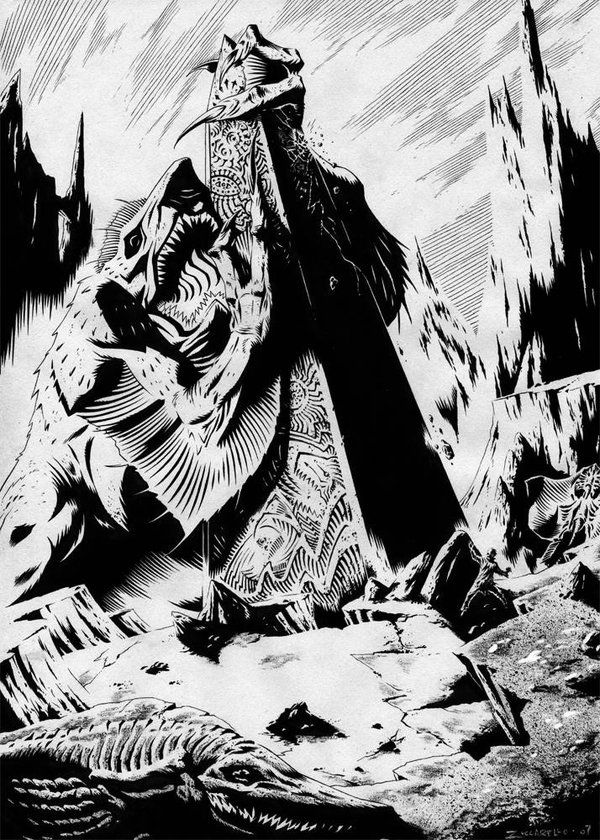
Dagon is a short, maddening tale. It was one of Lovecraft’s very first stories and is incidentally one of the best introductions to his writing style. It features many elements that should come to dominate his later body of work.
Dagon recounts the experiences of a now heavily morphine-addicted sailor.
An attack of a German sea-raider sinks a cargo ship. The narrator, a survivor of the attack, drifts through the Pacific Ocean for three days before he winds up on a putrid island. He speculates it was lifted from the ocean floor because of volcanic activities.
He ventures out and reaches a mound at the edge of an immeasurable canon. As he descends it, he finds a white stone monolith, engraved with various unfamiliar hieroglyphs all depicting aquatic creatures.
While he studies it, a giant creature emerges from the depths of the ocean to pray at the monolith.
The narrator flees the island in terror and eventually finds his way back into society. No one believes his story, and there’s no hint of volcanic activity or islands lifted from the ocean floor.
The narrator is haunted by visions of the creature he saw and terribly afraid for the future of mankind. He believes there will come a day when those creatures rise from the depth to drag mankind down into the seas and when all land will sink back to the ocean floor.
The story ends with him lamenting running out of morphine and that he can’t go on without it. Just then, he hears the noise of what he assumes to be an immense, slippery body throwing itself against the door. After he catches a glimpse of a terrible hand, he decides to throw himself from the window.
Even in one of his first stories, we can already see Lovecraft’s interest in ancient history and old civilizations. The titular name Dagon is a reference to a Philistine fertility deity.
While the story has no direct ties to the Cthulhu Mythos and was written much earlier, it’s still Lovecraft’s first story to feature its elements. Interestingly enough, Dagon is referenced again in his story The Shadow over Innsmouth, albeit only in name.
If you’re looking for a great introduction to Lovecraft’s overall style and many of the elements that made his story so popular than Dagon is perfect. It might be one of his earliest tales, but it’s clearly one of the best Lovecraft stories. One could do much worse for a first story.
15. Pickman’s Model
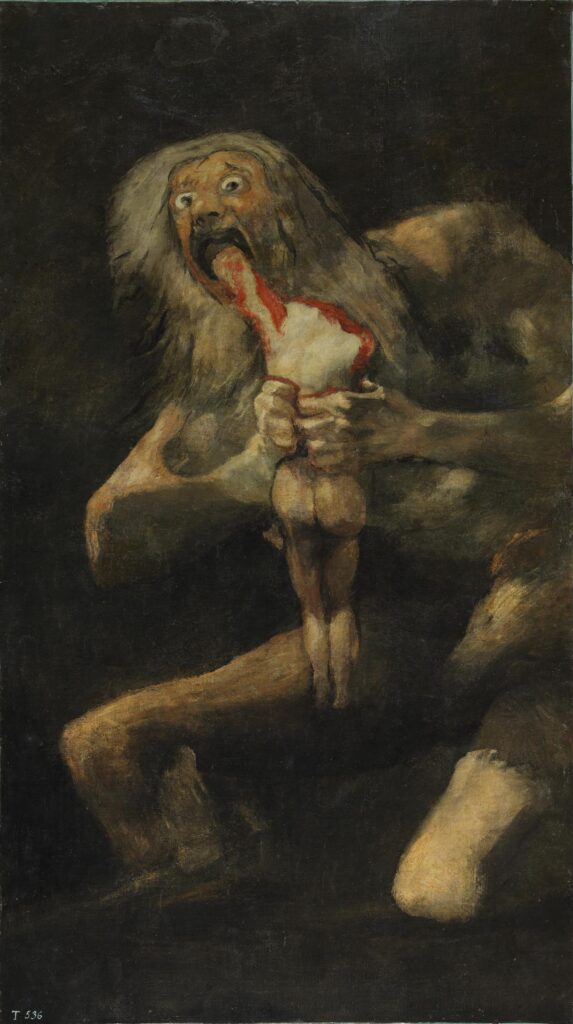
Pickman’s Model is another one of Lovecraft’s pure horror stories with no relation to the Cthulhu Mythos. It’s one of his last such stories before he fully ventured into his famous blend of horror and science-fiction and focused on his Mythos-related stories.
Pickman’s Model is a story regarding the titular artist Richard Upton Pickman. His works are brilliant, but they are so graphical and horrible that he’s shunned by fellow artists.
Eventually Pickman vanishes and the narrator, one of his friends, details what he found during a visit at Pickman’s home and a tour of his personal gallery.
Pickman presents him many of his works before he takes the narrator before a giant painting of an unearthly, vaguely canine, humanoid figure chewing on a human victim.
As Pickman rushes from the room with a gun, the narrator finds a small, rolled-up piece of paper attached to the painting. He hears multiple shots, but Pickman, upon returning, states that it was merely rats he shot at.
It’s only after the narrator left the artist’s home that he realizes he took the small piece of paper with him. As he unrolls it, he finds it to be a photograph. Not of the painting’s background, but the terrible creature depicted in it.
And thus, it becomes clear that Pickman’s inspiration, his model, was a creature that truly exists.
Pickman’s model is another fantastic Lovecraft story, albeit a simpler one when compared to most of his later tales. However, it’s yet again a prime example of Lovecraft’s theme of forbidden knowledge. The narrator states at the beginning of the tale he has an aversion to taking the subway. Only at the end do we find out why. It’s because the narrator now knows about the ghastly creatures that exist below the surface.
What I especially liked is the fact that Pickman vanished. It implies, while not stated directly, that the man must’ve found a dire end while trying to find more motifs for his art. One might also wonder if Pickman truly shot rats or if he was protecting himself from something different.
I also very much like the description of the painting and I can’t help but think of Francisco Goya’s Saturn Devouring His Son.
Pickman’s Model is a tale that I rarely see mentioned among his more popular tales. It’s for this reason I included it in this list of the best Lovecraft stories and I urge any fan of Lovecraft to read it.
14. The Case of Charles Dexter Ward
With over 50.000 words, The Case of Charles Dexter Ward is Lovecraft’s longest work and his only novel. Lovecraft originally wrote it as a short story, but he realized he’d more to say and wanted to explore the theme of New England’s witch-haunted dark more.
The titular character of Charles Dexter Ward is a young man from a prominent Rhode Island family who’s disappeared from a mental asylum. He’d been admitted after he showed inexplicable, psychological changes.
For the most part, the novel details the investigation by the Wards’ family doctor, Marinus Bicknell Willet, in an attempt to figure out what caused Charles’ sudden changes.
Willet learns that the young man was obsessed with his ill-reputed ancestor, Joseph Curwen. The doctor slowly unravels the truth behind the legends surrounding Curwen. The man was supposedly an alchemist but turned out to be a necromancer.
During a raid on Curwen’s farm, strange discoveries were made, not-quite-human figures were shot, and all present vowed to never talk about what they saw.
During his investigation, Willet learns that Charles resurrected his ancestor via the use of magical formulae. After this Curwen murdered Charles, took his place, and resumed his activities.
Because of a striking resemblance to Charles, he could fool strangers, but not his family, who noticed the aforementioned psychological changes.
While Curwen’s locked up, Willet’s investigation lead him to a bungalow in a small village. It was purchased by Curwen and turns out to be the location of his old home.
During his journey through the catacombs, he sees deformed monsters and uncovers the plan of Curwen and his fellow necromancers. While there, he accidentally resurrects an enemy of Curwen’s faints and awakens in the bungalow. The entrance to the catacombs seems to be sealed as if they never existed. From a note left to him in Latin, he learns how to kill Curwen.
Willet eventually confronts the man, kills him, and later learns that Curwen’s co-conspirators met similar brutal deaths.
While The Case of Charles Dexter Ward doesn’t seem to get a lot of love among fans of H. P. Lovecraft, I enjoyed the novel. It’s, however, somewhat different from Lovecraft’s usual work. It leans more towards occultism and alchemy, forbidden arts, and necromancy.
What’s most interesting is the resurrection of people via natural salts. It’s a concept that was first proposed by French doctor and alchemist Borellus.
The most enjoyable aspect of the novel was the way it was told. While the novel is named after Charles Dexter Ward, it’s the story of Doctor Marinus Willet and his investigations, slowly putting together what happened to the young man.
While the novel isn’t part of the Cthulhu Mythos, it still includes some of its elements. Curwen is in possession of the Necronomicon, there are hints of strange cult activities, and it includes the first-ever mention of the entity Yog-Sothoth.
Yet Lovecraft wasn’t pleased with the novel and regarded it below his personal standards. As we know, the man himself was his harshest critic. However, over the years many critics and scholars came to like the novel, some regarding it as one of his finest works.
As I said before, I enjoyed the novel. It can, at times, be a bit slow and feel a bit too long, but it wasn’t something that bothered me a great deal. However, it might be a hurdle for some other readers.
If you want to experience Lovecraft’s longest work and only novel, don’t be discouraged. It’s worthwhile of getting into and one of the best Lovecraft stories.
13. Facts Concerning the Late Arthur Jermyn and His Family
Facts Concerning the Late Arthur Jermyn and His Family was the very first and one of the best Lovecraft stories I ever read, and I absolutely loved it. Its placement here in the list is both because of appreciation for it as a story, but also for nostalgic reasons.
Still, the story holds an important place in my heart. It introduced me to Lovecraft, his style, and the twists that are often revealed at the end of his stories.
The story starts with a description of the ancestry of the titular character of Arthur Jermyn. He relates that his family has a peculiar physical appearance which first showed in the children of his great-great-great-grandfather, Sir Wade Jermyn.
The man was an explorer of the Congo region. His books about a strange civilization of white apes made him a laughingstock among peers. His wife was a reclusive Portuguese woman who he brought home from one of his many travels. He fathered a son before he was eventually confined to an asylum.
After this, the story continues to detail the life of the members of the Jermyn family line. Each member has their own peculiarities, and many of them are driven to the same regions Sir Wade explored.
After his father’s untimely death, it was Arthur who inherited the family’s possessions and moved to Jermyn House. Arthur is described as the strangest of Sir Wade’s descendants, having a very unusual appearance.
However, Arthur became a scholar, eventually visiting the Congo himself where he learns about the city of white apes, but also its destruction. However, he also learns of the stuffed body of their white goddess, which had supposedly gone missing.
When he returns to a trading post, a Belgian agent offers to obtain and ship the body to him. After several months, the body eventually arrives.
Arthur investigates the mummy only to rush from the room screaming before he commits suicide.
Lovecraft then, in the last part of the tale, reveals the contents of the goddess’ coffin. The ape goddess had a golden locket around her neck. On it were the Jermyn arms and it was of striking resemblance to Arthur Jermyn.
It’s thus revealed that Sir Wade’s supposed Portuguese wife was none other than the ape goddess. All his descendants were products of their union.
Facts Concerning the Late Arthur Jermyn and His Family is at its core a story about tainted ancestry, unearthing knowledge that might better be left undiscovered, and the terror it brings. It’s one of Lovecraft’s major themes that is featured in many of his later stories, for example, in The Shadow over Innsmouth.
After reading many of Lovecraft’s other works, especially his later great texts, one can tell that this is one of his earlier efforts. Still, it’s a great story, especially because of its slow steady progression, the execution of the final reveal, and the many hints throughout the story pointing towards it.
It was this structure that made me enjoy the tale the most. There’s something interesting about following the peculiarities of each of Arthur’s ancestors as more and more details are revealed. One can almost tell that there’s something strange and uncanny about Sir Wade, his Portuguese wife, as well as the rest of the family.
What really impressed me about this tale was how well the final revelation at the end was handled. It revealed not only that Sir Wade’s wife was actually one of the apes, the ape goddess, but that also Sir Wade must’ve been the White God the apes worshipped.
I still remember the day when I first finished reading this tale. I sat there, amazed at how well the ending was executed, and how many hints throughout the story had pointed towards it. To get there, though, one has to read through the chronology of the Jermyn family. It was something I personally enjoyed, but that might not be for everyone, and some people might find it a dense and dry read.
Still, it’s a great tale and well worth the addition in this list of the best Lovecraft stories.
12. The Outsider
The Outsider is early Lovecraft at his absolute best. The story is another great introduction to Lovecraft’s style, but is also reminiscent of Poe’s. It is definitely one of the best Lovecraft stories of all time.
We can see Lovecraft’s descriptive and verbose style as we follow the narrator through a world of vine-encumbered trees, but the castle that’s infinitely old and infinitely horrible makes us think of Poe and his gothic imagery.
The Outsider details the miserable and lonely life of an individual that’s all by himself. His memory of others is vague, and he can’t recall anything about himself.
He lives in a dark decaying castle, amid an endless forest of high trees that block out the sun. He’s never left his home, and the only knowledge he has of the outside world is from the antique books that line the walls of his castle.
Eventually, determined to free himself, he climbs a ruined staircase to the castle’s highest tower. Once there, he finds a trapdoor in the ceiling.
Upon pushing it open he doesn’t find himself at a great height, but in a churchyard, in what he assumes to be another world. The narrator’s overjoyed for he can finally behold what he’s only read about so far.
As he wanders the countryside, he comes upon another castle, which he finds maddeningly familiar. At the castle, many people have gathered in revelry.
Longing for human contact he makes his way inside. The people suddenly become terrified, scream, and flee from the room. As he stands alone, he’s terrified of what must be near him and what scared everyone else. He crosses the room in search before he detects a presence approaching him.
It’s a terrible creature, one that has the ghoulish shades of decay upon itself, an abhorrent travesty of the human shape.
In shock, he loses his balance and touches the creature. Horrified, he runs and plans to return to his castle only to find the trap door long gone. He realizes then that he’ll forever be an outsider.
And in the last line, Lovecraft reveals the terrible truth, for when the narrator touched the creature, all he felt was the ‘cold and unyielding surface of polished glass.’
Undoubtedly one of Lovecraft’s finest works. It’s a beautiful and poetically melancholic story rip with the gothic themes so common in the works of his literary predecessor Edgar Allan Poe.
More so than in Poe’s stories, though, there’s an overall sadness to the main character, one that’s depressing, making The Outsider a beautifully sad tale.
One might wonder what the narrator’s strange, original world with its dark decaying castle and towering trees is. To me, it always felt like it describes the narrator’s afterlife, and the books that line the castle walls are the memories of his earthly life. When he eventually escapes, he finds himself in a graveyard as if he’s reawakened not from a different world, but the grave.
The Outside is a pretty unique story in Lovecraft’s body of work, for the narrator isn’t a scholar or man of science who discovers a terrible secret about reality itself. Instead, it’s a very personal story, and the narrator is nothing but a lonely figure longing for contact with others.
The Outsider is without a doubt one of Lovecraft’s finest works that presents is with beautiful gothic imagery and a feeling of almost palpable loneliness. It’s a fine addition to this list of the best Lovecraft stories.
11. The Music of Erich Zann
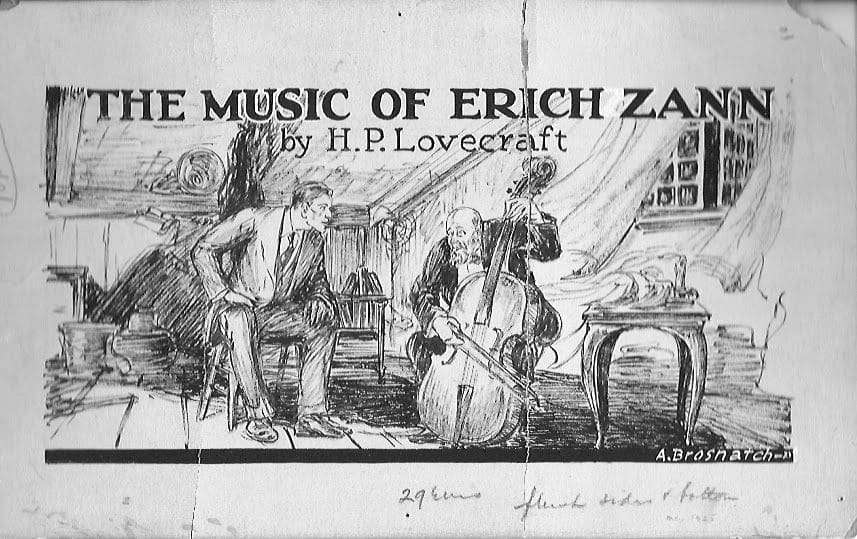
The Music of Erich Zann is one of Lovecraft’s earliest examples of cosmic horror and one of the best Lovecraft stories. What’s especially interesting is that the story bears no connection to the Cthulhu Mythos. Instead, it’s a simpler, more intimate story.
The story features a university student who moves into a cheap apartment, in an old building. It’s located in a street in Paris named the Rue d’Auseil bordered by a giant wall.
Few people live at the place. One is the titular character of Erich Zann, an elderly German violinist. The man lives on the buildings top floor where the only window that allows a look above the giant wall is located. At night, the man can be heard playing strange melodies on his instrument.
Before long, the narrator, intrigued by the old man’s music, approaches him and asks if he can listen to his music. When he hums a specific tune, Zann urges him to move to a lower apartment, so he won’t hear his music anymore. He promises him, however, to invite him to listen to his other music.
Zann returns to his antisocial behavior and refuses to let the narrator listen. After this, the young man’s curiosity drives him to listen to Zann’s music in secret.
One night he hears the old man scream and when he barges into his apartment, Zann wants to explain everything and starts writing. Soon a distant sound is heard, and Zann continues playing his music frantically.
The music he’s now playing is horrible, and the student realizes it’s keeping something away. The sounds from outside grow louder, the window shatters and an unnatural wind blows Zann’s pages away.
At this moment the narrator’s finally able to see outside. Beyond the wall, he only finds a terrible black void, an infinite abyss of chaos.
The wind soon blows out the candles, leaving Zann and the narrator in absolute darkness. As he moves, he feels chilling things brushing against him. When he tries to bring Zann to follow him from the room, he discovers the old man’s dead, yet his body’s still playing the violin.
The narrator runs from Zann’s apartment, the building, and eventually from not only the neighborhood but also the Rue d’Asueil.
Writing about the incident now, the narrator could never find the street again. It does not appear in any maps and no one but him has ever heard about it.
Lovecraft considered The Music of Erich Zann one of his best stories. He wasn’t alone in this assessment though, because it was one of the few stories that found appreciation during his lifetime and which was frequently anthologized.
It’s another, shorter story, but one rip with a heavy atmosphere. The mysterious street, the apartment building, and the old German violinist with his strange music set a great tone for the terrible final.
It’s yet another one of Lovecraft’s stories in which a character is confronted and witnesses something far beyond his understanding.
Even more interesting, the narrator appears to be the only person to know about the Rue d’Asueil. It begs to wonder what place he was at.
The Music of Erich Zann is also a story I enjoyed a lot for a personal reason. It features of music as a major plot element similar to novel New Haven.
It’s an interesting and fantastically done tale and without a doubt one of the best Lovecraft stories.
10. The Lurking Fear
We enter the top ten with another one of Lovecraft’s earlier works of pure horror. It’s also one of the best Lovecraft stories.
Our nameless narrator is a reporter who makes his way to Tempest Mountain after various reports cite the attack of an unidentified creature.
It all started during a huge thunderstorm. An entire village was destroyed and all of its inhabitants have since gone missing.
During his investigation, the narrator learns about the Martense Mansion, a century-old Dutch home, now long abandoned.
The narrator eventually visits the old mansion and brings along two of his friends. When another thunderstorm hits they are forced to stay the night at the mansion. While the place is entirely deserted, they still take precautions in case they are attacked. Eventually, they fall asleep. Upon awakening, the narrator realizes his companions are gone, but not before seeing a grotesque shadow.
The story continues as the narrator investigates the murders that have taken place as well as the sightings of the creature with a fellow reporter.
Before long he learns more about the Martense family, their isolated nature, including inter-marriage and their eventual disappearance.
Before long, as he investigates the mansion, he learns of the true, disturbing nature of the Lurking Fear and what became of the Martense family.
There’s much to be discovered in this story, and Lovecraft lures us into wrong directions multiple times before he gives us a fantastically done revelation.
The Lurking Fear is a story that comprises four installments, each detailing the narrator’s continued investigation and the slow revelation of the ghastly mystery of Tempest Mountain and the Martense Mansion.
It’s a story that’s very reminiscent of American Gothic and thematically, and stylistically similar to another one of his great, early horror stories, The Rats in the Walls.
The story’s setting adds a lot to the Gothic feeling it gives off, not only for the old, decrepit mansion.
There’s the isolated setting, but also the prevalent thunderstorms that hang as heavy over Tempest Mountain as the mystery the story contains.
While the Lurking Fear might be one of Lovecraft’s earlier works, it’s still one of his best pure horror stories. There are no Elder Gods here, no creatures from Cthulhu Mythos, instead, the horror is entirely man-made.
The Lurking Fear is one of my favorites and clearly one of the best Lovecraft stories.
9. Dreams in the Witch House
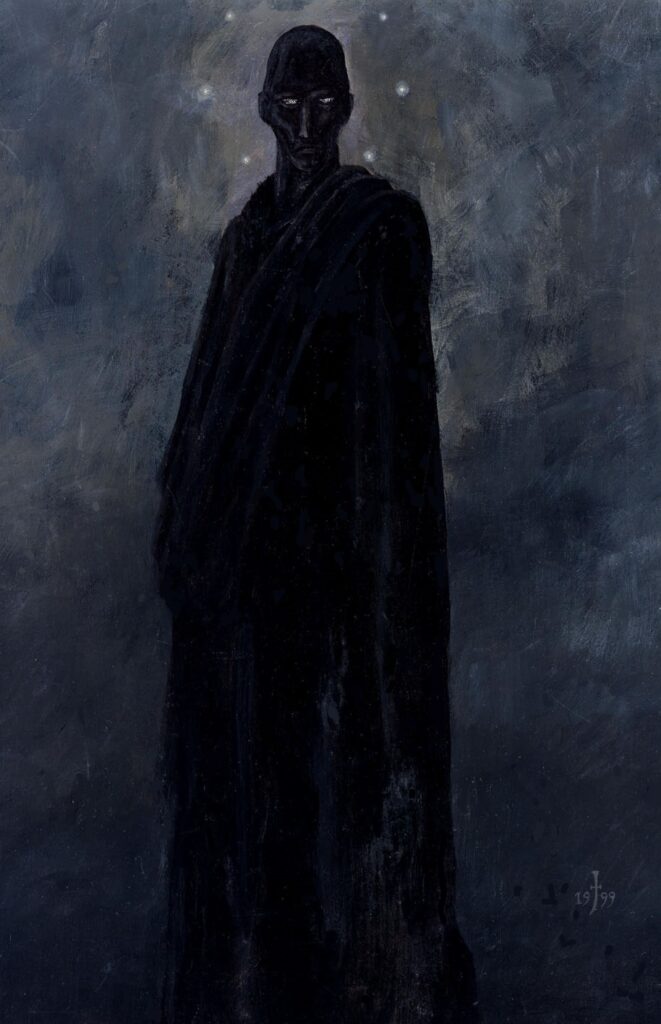
The Dreams in the Witch House is one of Lovecraft’s later tales. With this story, we’re finally ready to jump into Lovecraft’s later, most famous body of work and the Cthulhu Mythos. It’s these works that are generally regarded as the best Lovecraft stories.
And what a jump it is. The Dreams in the Witch House is one of Lovecraft’s strangest, most weird stories. It can best be described as witches traveling to alternate planes of existence using the power of geometry and mathematics.
It’s exactly for this reason that the story stands out. The story is more in-depth with its use of science and mathematics than any of his other stories.
Our narrator, Walter Gilman, is a student of mathematics and folklore at Miskatonic University.
He rents the attic of a house in Arkham that’s rumored to be cursed and known as the ‘Witch House’. A woman named Keziah Mason once lived there, an accused witch who mysteriously disappeared from a jail cell in Salem in 1693.
Gilman soon learns that many of the occupants of the attic have died prematurely. Even stranger, he notices that the dimensions of the attic differ from those of normal geometry.
He theorizes that this structure could allow one to travel from one plane of existence to another. Gilman soon experiences bizarre dreams in which he floats through an otherworldly space of strange geometry, color, and sounds and notices various entities.
At other nights, he’s haunted by visions of the witch Keziah and her rat-bodied familiar, Brown Jenkins. However, he soon doubts that those are just visions.
In yet another dream, Gilman visits the city of the Elder Things and brings back evidence of actually having been there.
Eventually, his dreams escalate, as he signs the Book of Azathot under the command of Keziah, her familiar, and an unknown entity known as The Black Man. Gilman is then forced to be an accomplice in the kidnapping of an infant. Upon waking, he uncovers mud on his feet and soon learns of the news of an infant going missing.
On Walpurgis Night he dreams that the witch wants to sacrifice the infant in a bizarre ritual. He strangles the witch, but Brown Jenkins can complete the ritual by biting through the infant’s wrist.
He eventually details the entire story to a fellow boarder in the home. The man doesn’t believe the tale at first, but then bears witness to Brown Jenkins eating his way through Gilman’s chest.
Eventually, the house is abandoned and later razed. During this task, the workers find not only the skeleton of Keziah and Brown Jenkins but also her books on dark magic and, hidden between the walls, a space filled with the bones of children.
The Dreams in the Witch House is an interesting story, especially for its inclusion of science, mathematics, and geometry. Lovecraft was supposedly inspired by attending a lecture of Willem de Sitter, a Dutch mathematician, physician, and astronomer who talked about gaining a deeper understanding of the universe by a combination of geometry and the curvature of space.
While many of his later works can be categorized as a blend of science-fiction and horror, The Dreams in the Witch House still stands out as rather unique.
There’s of course many of Lovecraft’s usual elements of cosmic horror to be found in this tale. We see other races, including Elder Things, Nyarlathotep, and even Azathot.
Yet, all is not well with this story. While I loved the imagery, the ideas, and the grand cosmic landscapes conveyed, the plot itself was a little too weird to me. It seemed almost hackneyed and strangely convoluted because it includes so many different elements.
Still, it’s a good, strange story, especially because of its ideas and its imagery. Even if the plot might not be its strongest point, it’s still worth a read.
8. The Shadow over Innsmouth
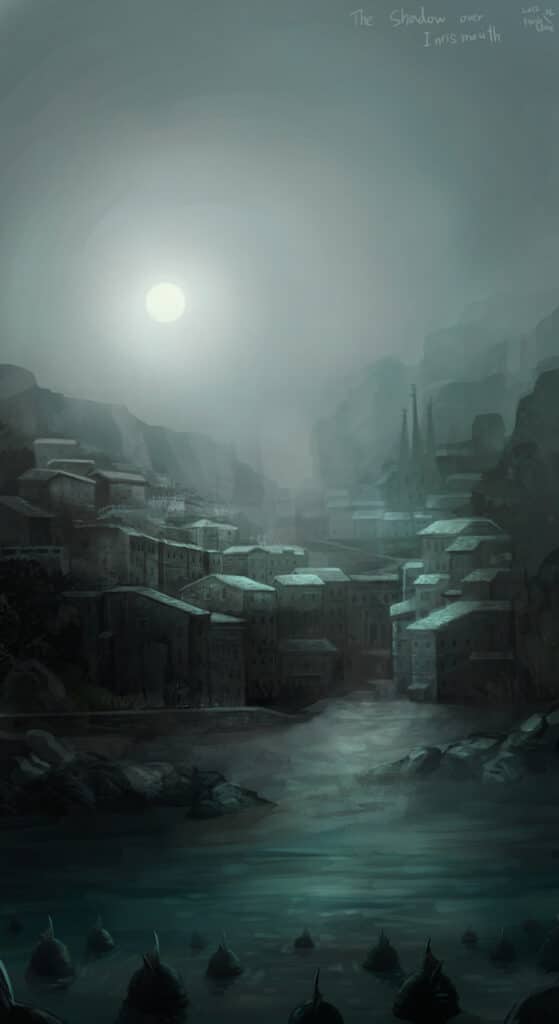
The Shadow over Innsmouth is a fundamental work of the Cthulhu Mythos, introducing us to one of his most iconic creations, the Deep Ones, a race of intelligent ocean-dwelling creatures.
The narrator of this story is an unnamed student on a tour through New England. Eventually, he decides to visit the small town of Innsmouth.
While he waits for the bus, he talks to the people in the neighboring town of Newburyport. Everyone there talks about Innsmouth only in superstitious tones.
Innsmouth turns out to be a mostly deserted fishing town, populated by people who walk with a distinctive, shambling gait, have strange narrow heads, flat noses, and bulging, stary eyes.
The only normal person seems to be a grocery clerk from nearby Arkham who hands him a map of the town and tells him about a local man named Zadok Allen. The man’s an alcoholic, and if the narrator gets him drunk enough, he might reveal a few things about Innsmouth. He also gets warned not to venture too deep into town. Outsiders aren’t welcome and have occasionally disappeared.
Upon meeting with Zadok, he learns that an Innsmouth merchant named Obed Marsh discovered a race of fishlike humanoids known as the Deep Ones. Obed established a cult, the Esoteric Order of Dagon, which offered them human sacrifices in exchange for wealth.
When Obed and his followers were arrested, the Deep Ones attacked the town and killed half the population. The survivors had no other option but to follow Obed’s practices and were forced to breed with the Deep Ones. The resulting offspring look like humans in their early life but eventually transform into Deep Ones themselves.
These ocean-dwellers also have plans to capture the surface world and use Shoggoths to shape it to their liking.
At the end of their talk, Zadok sees strange waves approaching and urges the narrator to leave town immediately. He’s unnerved by all this, but ultimately dismisses the story.
When the bus has trouble, the narrator has no other choice but to spend the night in the Gilman House, a musty hotel in town.
While attempting to sleep, he hears noises at his door, as if someone’s trying to force himself in. He escapes via the window and through the streets while a town-wide hunt for him occurs. At times he’s even forced to mimic the peculiar walk of the locals as he makes his way past several search parties.
Eventually, he makes his way towards railroad tracks. There he bears witness to a procession of Deep Ones whose appearance is enough to make him pass out in terror. He awakes unharmed and finally escapes the town.
Years later, after lots of research, he discovers that he’s a descendant of Obed Marsh himself and is now starting to change into a Deep One himself. He accepts his fate and is prepared to join the Deep Ones in their city.
The Shadow over Innsmouth holds a very special place in Lovecraft’s body of work. It’s the only one of his stories that contains scenes of genuine suspense and even action. The entire scene at the hotel and the subsequent flight of the narrator are uncommon for Lovecraft, but very well done.
Usually, the best Lovecraft stories focus on slow, deliberate investigations of mental surprises and slipping sanity.
That’s why The Shadow over Innsmouth is a rare gem. Lovecraft, however, wasn’t fond of the story and rejected it, calling it hackneyed and regarding it as one of his worst efforts. In my opinion, he succeeded very well in the tale itself, and in conveying action and suspense.
It’s not only these scenes that make the story work. It’s the general idea of a person alone in a mysterious, degenerative community that is inherently fascinating and lends itself perfectly to the horror genre. Yet, Lovecraft makes things even worse, by rendering his inhabitants not just backward or degenerate but by making them barely human creatures.
What helps to bring forth this atmosphere is Lovecraft’s descriptions of the gloomy, crumbling town of Innsmouth as well as the descriptions of his ghastly inhabitants. It’s this gloomy atmosphere that lures you in, and we know from the moment the narrator sets foot into Innsmouth that it’s far from a normal town.
Innsmouth also features another one of Lovecraft’s major obsessions, the theme of tainted ancestry and corrupted blood. It’s a theme that we also encountered in his stories Facts Concerning the Late Arthur Jermyn and His Family and Rats in the Walls. It’s interesting to note the narrator’s end especially which might describe Lovecraft’s own latent fears. Both his parents were admitted to and eventually died at mental institutions.
Another theme we see at work is that of man’s messing with powers and creatures far beyond their understanding. In his greed, Obed Marsh communed with the Deep Ones which ultimately have dire consequences for all of Innsmouth.
The Shadow over Innsmouth was also the only one of Lovecraft’s stories to be published in book form during his lifetime. However, the book was riddled with typographical errors, only a few hundred copies were printed and even less sold, making it a failure.
Yet, nowadays, The Shadow over Innsmouth is one of Lovecraft’s most popular and well-regarded stories.
The only problem I personally have with the tale is its ending. It feels too much of a coincidence for coincidence’s sake and Lovecraft’s attempt at bringing the narration full circle. The narrator was a man who accidentally, and out of curiosity, stumbled into the small town of Innsmouth. Yet, in the end, it’s revealed that he himself is a descendant of Obed Marsh and will eventually turn into a Deep One himself. It’s a bit of a stretch, one that’s a bit too long for me.
Apart from that, it’s a fantastic and unique tale.
7. The Call of Cthulhu
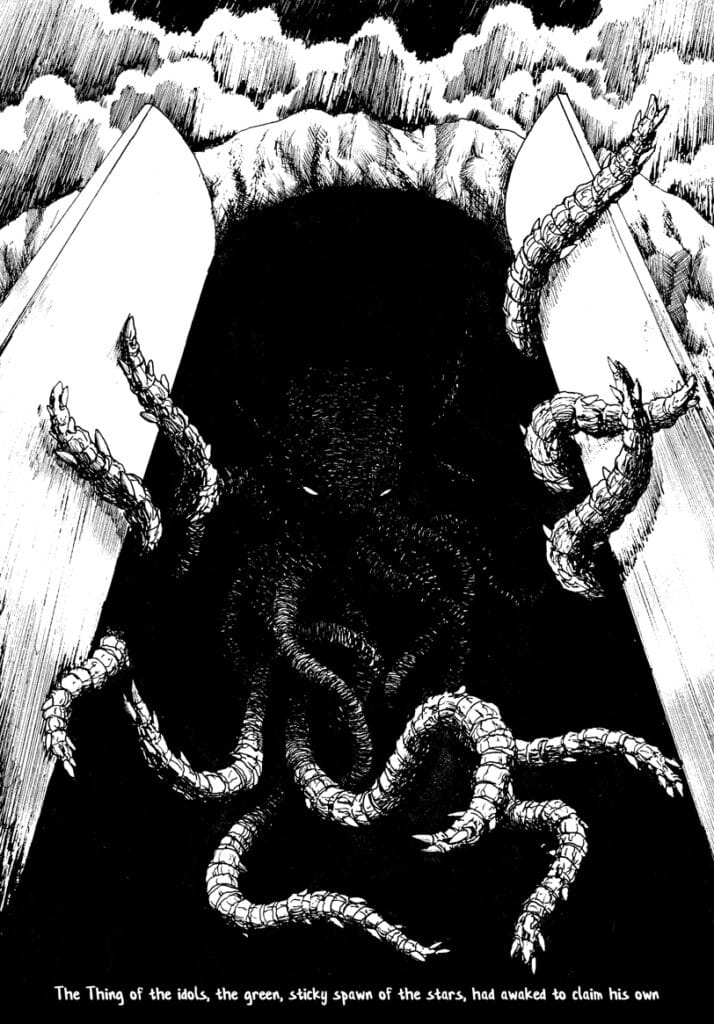
And so we finally come to the Call of Cthulhu, Lovecraft’s most popular piece of work and, without a doubt, one of the best Lovecraft stories of all time.
Robert E. Howard described it as a masterpiece, while French novelist Michel Houellebecq described it as the first of Lovecraft’s great texts. Many other writers hold it in high regard.
Yet, The Call of Cthulhu is not only popular, but it served as the basis for the entire Cthulhu Mythos, which makes the story even more popular and influential.
That’s the reason it’s another perfect introduction for anyone new to Lovecraft, the Cthulhu Mythos, or cosmic horror in general.
The Call of Cthulhu is written differently from most of Lovecraft’s other stories. It features a more fragmented way of storytelling. It ties together various incidents by a narrative framework which allows the horror to slowly creep in before the story comes to inclusion that includes even its narrator.
The narrator, Francis Wayland Thurston, details what he found in the notes of his great uncle, a prominent professor at Brown University in Providence who recently died.
As outlined before, the story details the various notes, each containing incidents related to some sort of entity.
The first chapter regards a bas-relief sculpture of a strange entity that simultaneously contains the picture of an octopus, a dragon, and a human caricature. A pulpy, tentacled head surmounted a grotesque and scaly body with rudimentary wings. The sculpture was created by a student who based it on a dream of great Cyclopean cities of titanic blocks and sky-flung monoliths, all dripping with green ooze and sinister with latent horrors.
It’s here that Cthulhu and the dead city of R’lyeh are first mentioned.
As the story continues we learn that there are strange cults who worship the same creature and who own similar sculptures.
It’s here that we encounter two of Lovecraft’s most famous quotes:
“Ph’nglui mglw’nafh Cthulhu R’lyeh wgah’nagl fhtagn” (“In his house at R’lyeh, dead Cthulhu waits dreaming.”)
“That is not dead which can eternal lie, And with strange aeons even death may die.”
In the last chapter of the story, we learn of a sailor who eventually arrives at nothing less than R’lyeh, raised from the depth of the sea, and who encounters Cthulhu himself.
The narrator tries to meet up with the sailor regarding his experiences, only to learn that the man was murdered. It’s at this point that the narrator realizes that he’s in danger too, for he knows too much, and the cult still lives.

The Call of Cthulhu is another fantastic story, written uniquely. It contains all the hallmarks of a typical Lovecraft and Cthulhu Mythos story: strange influences, non-Euclidean geometry, elder beings, and of course, people driven to insanity. What’s interesting though is that while Cthulhu, the immense Old One, slumbering within the non-Euclidian walls of the dead city of R’lyeh, is Lovecraft’s most famous creation, the being never appears in any other stories. It’s only mentioned by name, here and there.
While I enjoyed the story tremendously, I still have my problems with it.
Many people hail The Call of Cthulhu as Lovecraft’s best work. Yet, I can’t help to put it lower on the list. The reason is that the protagonist feels too removed from the story and the general action. This makes the story almost feel like an essay of strange incidents.
It’s this non-traditional structure that combines a traditional narrative with journals of various witnesses that make the story work in one way but doesn’t in another.
In essence, The Call of Cthulhu is a story within a story within a story.
It’s an intriguing and interesting tale. Each incident adds a little more to the general puzzle until we’re greeted with an appearance of Cthulhu himself. However, other stories by Lovecraft have a more finished feel to them and a tighter narrative, making them, at least to me personally, more satisfying.
This doesn’t mean it’s a bad story, by no means. It’s after all one of Lovecraft’s great texts and deservedly mentioned as one of his best by fans. I just feel there are other stories more worthy of praise while The Call of Cthulhu can be a bit overrated.
Still, I’d recommend the story to anyone interested in Lovecraft, the Cthulhu Mythos, and cosmic horror.
6. The Rats in the Walls
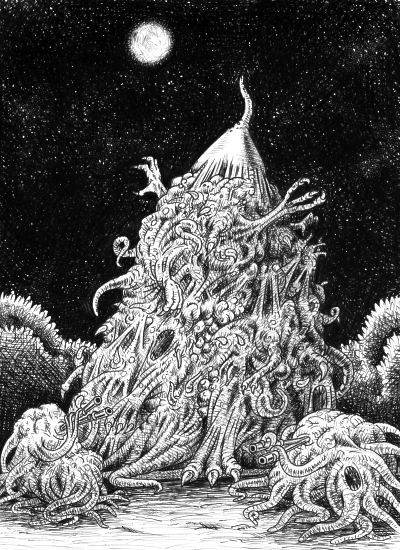
The Rats in the Walls is another one of Lovecraft’s pure horror tales and one of his earlier horror stories. Yet, it’s not only the best of those early horror tales, it’s also one of his best Lovecraft stories of all times.
The Rats in the Walls is the story of an old American, Delapore. After the death of his son in WWI, the man returns to his ancestral estate in England.
The home was abandoned when his only surviving ancestor fled the place. Delapore restores the estate, but after moving in, he’s frequently haunted by the sounds of rats behind the walls.
It’s not only the rats that trouble him. He’s also plagued by ghastly dreams, featuring a devilish swineherd and his disfigured livestock who are eventually eaten by a flood of rats.
Eventually, Delapore and a friend of his son named Norrys uncover a secret tunnel below the altar in the building’s basement.
With a group of explorers they descend and find a giant grotto. The buildings there reaching from ancient times until the time when his ancestor fled the building.
Human bones are everywhere, some even in cages. They realize they’ve found the dwelling of a cannibalistic underground society that raised human cattle.
And this is where Delapor’s dreams stem from. After his ancestor fled, the rest of the human cattle were left behind to be devoured by the rats inhabiting the cesspits of the city.
In one of those, Delapore finds a skeleton among the rest wearing a ring with his family badge on it. This proves that the cannibalistic society was no other than his own family.
Upon this revelation, Delapore snaps, attacks Norrys, and begins eating him. All the while, he rambles on in a mixture of Middle English, Latin, and Gaelic before his voice devolves into a cacophony of animalistic grunts.
Delapore’s eventually subdued by the rest of the explorers and placed in a mental institution. In there, he desperately pledges his innocence, stating that it was ‘the rats, the rats in the walls’ who ate Norrys.
And in this cell, Delapore continues to be plagued by the sounds of rats in the walls.
While the plot, with its old family mansion and the strange sounds behind the walls, it’s the ending that will surprise and even haunt you. It’s one of the best climaxes Lovecraft ever wrote, only topped by that of The Whisperer in Darkness and The Shadow Out of Time.
Delapore’s madness and his insane ramblings might almost suggest that he’s devolving, changing back to the way of his ancestors, committing the same deed, and speaking the same way.
The Rats in the Walls might be one of Lovecraft’s most depraved stories, especially for the narrator Delapore. There’s not only the knowledge of his tainted ancestry, but also the deed he committed. And in the end, he’s left in an asylum where he’s constantly tormented by the sounds of the rats.
An interesting tidbit is the idea that the story might be a nod to Lovecraft’s literary icon Edgar Allan Poe and his story The Tell-Tale Heart. Both narrators are haunted by sounds, and are, ultimately, driven mad by them.
The Rats in the Walls is a true masterpiece of horror literature. It’s the best of Lovecraft’s earlier horror stories, and one that will stay on your mind for quite a while after reading it.
I can’t recommend it enough.
5. The Dunwich Horror
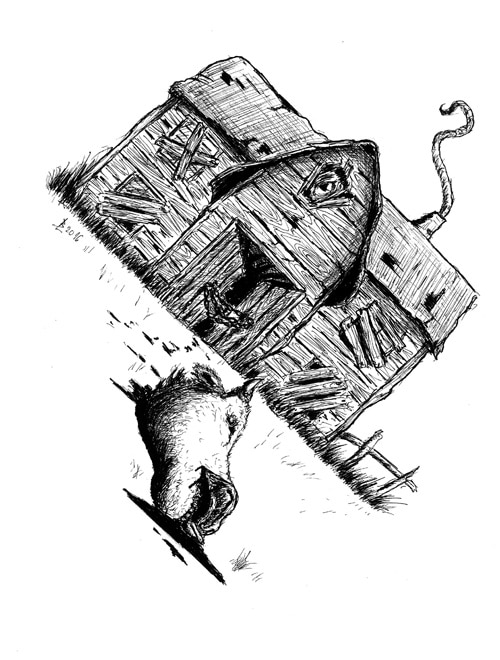
The Dunwich Horror is one of the best Lovecraft stories and one worthy to open the top five with.
The story begins by describing the strange circumstances of the birth of the deformed son of an albino mother called Lavinia Whateley and an unknown father.
This child, called Wilbur, matures at an abnormal rate. He begins to read and write at an age far younger than other children and reaches adulthood within a decade.
The locals shun the family while animals fear Wilbur and despise his odor. Wilbur’s grandfather, on the other hand, is rumored to be a sorcerer who teaches him rituals and witchcraft.
The townspeople soon notice another peculiarity about the family. Wilbur’s grandfather buys more and more cattle, but the size of his herd never increases. Even worse, more and more cattle seem to disappear or are covered in terrible wounds.
It soon dawns on the townspeople that Wilbur and his grandfather house a strange, unseen presence in their home, one who requires the two to frequently modify their home.
Eventually, Wilbur’s mother disappears, his grandfather dies, and the strange entity seems to occupy the entire house.
Wilbur visits the library of Miskatonic University, requesting to rent their copy of the Necronomicon, so he can complete his rituals.
When he’s denied by the librarian, Doctor Henry Armitage, he breaks into the library at night but is attacked and eventually killed by a guard dog. When Doctor Armitage and two of his colleagues, Professor Warren Rice and Francis Morgan arrive, Wilbur’s corpse melts before their eyes.
After Wilbur’s death, no one’s left to care for the entity in the farmhouse. It eventually breaks free and rampages across Dunwich. The entity seems to be an invisible monster and in the course of the next several days, two families and several policemen are killed by it.
Eventually, Armitage, Rice, and Morgan learn what the entity might be and how to fight it. They use a magic powder to render the creature visible before destroying it with a spell.
Before being destroyed the creature babbles in an alien tongue before it screams for Yog-Sothoth, its father to help him. It’s then revealed what the creature truly is, Wilbur’s twin brother, though it took more after his father.

The Dunwich Horror is a story that was written a few years after The Shadow over Innsmouth. Yet, it follows a similar thematic, namely that of human-monster offspring.
It’s not only this thematic but its many reoccurring elements, Arkham, Miskatonic University, the Necronomicon, and the entity Yog-Sothoth, make it a core story of the Cthulhu Mythos.
The Dunwich Horror is a story written in Lovecraft’s usual delightful style. It lends itself perfectly to the first half of the story. It’s here that Lovecraft focuses on Wilbur, his deformities, the old farmhouse, and everything that’s going on in his over-descriptive and flowery vocabulary.
What’s so great about this story is the slow and deliberate development. The first half of the story is dedicated solely to Wilbur and his family. It might be one of Lovecraft’s most effective, drawn-out works of horror.
After his introduction, and for the first half of the story, one’s inclined to think that Wilbur’s the protagonist of the tale. Only when he suddenly dies are the real protagonists revealed. It’s also the same time that the Dunwich Horror finally breaks free.
One thing that makes the story stand out among Lovecraft’s body of work is that it ends in a far more optimistic tone than his other stories. It’s only in the Dunwich horror that mankind wins over the dark entities they are confronted with. Wilbur, the terrible half-breed is unceremoniously killed by a guard dog. The titular Dunwich Horror, a spawn of Yog-Sothoth itself, is destroyed by men of science-
The Dunwich Horror is a fantastic story, one that stands out in various ways and that’s clearly one of Lovecraft’s most celebrated works and one of the best Lovecraft stories of all time.
4. The Colour Out of Space
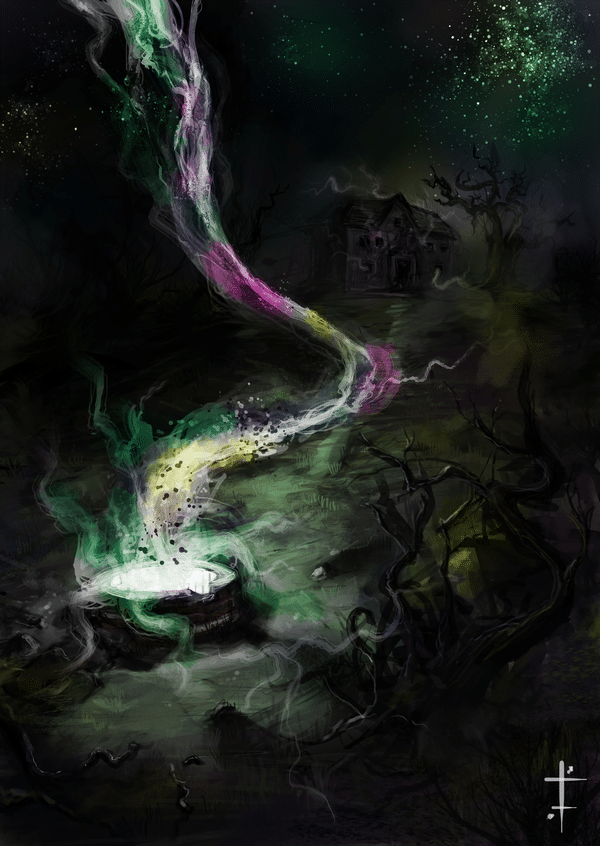
The Colour Out of Space is Lovecraft’s most original story and features his most original creation. It was also Lovecraft’s personal favorite among his body of work.
The story has frequently adapted, most recently as a movie by the same name starring Nicolas Cage.
The Colour Out of Space was also the first of his later, most popular blends of science-fiction and horror.
Lovecraft’s motif when creating the story sprang from his dissatisfaction with how aliens from outer space were portrayed in fiction at the time. What he wanted was to create an entity that’s truly alien and doesn’t resemble a human being or any other earthly creature.
The Colour Out of Space is told by an unnamed narrator. He wants to uncover the secret behind a place known as the blasted heath.
When he gets no information from any of the townspeople, he seeks out a supposedly crazy man named Ammi Pierce. From this man, the narrator learns what happened to a farmer named Nahum Gardner and his family who used to live on the cursed property.
It all started when a meteorite crashed on Gardner’s land in June 1882. The meteorite puzzled scientists who weren’t able to discern its origin. As it shrinks, it leaves behind globules of color which are only referred to by analogy since their color itself is outside the visible spectrum.
In the following season, Gardner’s crops grow unnaturally large and abundant but are discovered to be inedible. Gardner becomes convinced that the meteorite poisoned his soil.
The infection soon spreads to the surrounding vegetation and animals altering them in unusual ways.
When Gardner’s wife goes insane, he slowly isolates himself from the rest of the farming community, only corresponding with Ammi Pierce who becomes his only contact to the outside world.
At this point, the vegetation outside Gardner’s home erodes into gray dust and the water becomes tainted. Soon after the livestock turns gray as well and dies, their meat becoming inedible.
One of Gardner’s sons first goes mad and dies. Another one, Merwin vanishes after being sent to retrieve water from the well.
After two weeks without contact, Ammi Pierce makes his way to the farm and learns of the terrible horror that happened there.
Zenas, Gardner’s lost son has disappeared. In the house, he stumbles upon Gardner’s wife who’s been infected by the color. He puts her out of his misery and upon fleeing the house he stumbles upon Gardner who succumbs to the influence of the color.
Pierce later returns to the farmstead with others, including a doctor to identify Nahum’s remains. As they investigate, they discover the skeletons of both Merwin and Zenas at the bottom of the well.
As they reflect on their discovery, a light shines from the bottom of the well. Before they can react, the color emerges from it and spreads over everything in the vicinity.
As they flee, they bear witness to the color finally vanishing into the sky. It’s Pierce alone who turns back. He notices that a small portion of the color fails to follow the rest and sinks back to the well.
Thus Pierce knows that part of the alien entity is still on Earth, which disturbs him deeply. In the time following the Gardner family’s demise, all neighboring families abandon the area.
The Colour out of Space is always included among Lovecraft’s most popular and in lists of the best Lovecraft stories.
Interestingly enough, the story was in part inspired by the construction of the Scituate Reservoir in Rhode Island. Large parts of the town of Scituate were flooded, forcing most its residents to dislocate. One can easily see the similarity, namely numerous people being forced to leave their homes. Only in Lovecraft’s stories, it’s not because of a flood, but because of an alien entity.
There’s an overwhelming, dark atmosphere that hangs over The Colour Out of Space from beginning to end. It gives the reader a sense of dread that only worsens as the story continues.
There’s a slow lurking horror that starts to spread when the color influences everything around Gardner’s farm. This feeling is emphasized by the tragic story of the family. There’s a feeling of helplessness, of despair that lasts until their eventual doom at the end of the tale.
The Color Out of Space is undoubtedly one of Lovecraft’s finest pieces of work, especially because of the entity, the titular color. We know nothing about it, we can’t fathom or even see it and we’ll never know if it was even conscious.
It’s a fantastic story that I highly recommend to any fans of Lovecraft and that serves as a study on how to create a truly alien entity.
3. The Whisperer in Darkness
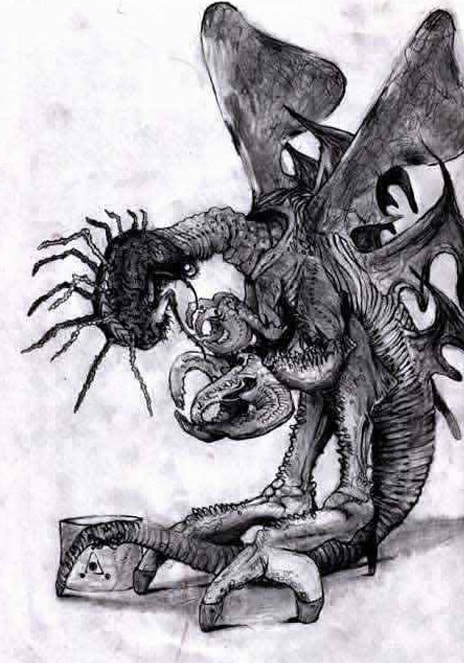
The Whisperer in Darkness is one of my absolute favorite Lovecraft stories, one I regard as one of the best Lovecraft stories of all time.
Incidentally, it’s also one of the most important stories in his body of work. It introduces us to the Mi-Go, an extraterrestrial species of fungoid creatures and thus broadening the scope of his narrative.
While the Cthulhu Mythos might not be at the center point of the story, it still contains many of its elements and is without a doubt a masterpiece of cosmic horror.
The Whisperer in Darkness is the story of a man named Albert N. Wilmarth, who’s an instructor at Miskatonic University in Arkham.
The story begins with newspaper reports of strange things floating in the rivers after a flood in Vermont. Soon a conspiracy spreads, surrounding what’s supposedly sightings of extraterrestrial creatures.
Wilmarth remains skeptical, siding with those who blame the stories on old legends about monsters living in the hills. This changes when he receives letters from a man maned Henry Wentworth Akeley, living in an isolated farmhouse. Akeley claims he can prove the existence of the creatures.
The two continue to exchange letters. Akeley details accounts of an extraterrestrial race in communication with human agents worshipping Cthulhu and Nyarlathotep.
These human agents soon begin to intercept Akeley’s messages, harass him before the situation escalates and gunfire’s exchanged. Akeley reports having killed one of the extraterrestrial beings and describes their disgusting nature.
Soon after, Akeley seems to reconsider. In a new letter, he explains to Wilmarth that he’s met with the beings and learned they are peaceful. They even taught him many things, far beyond our imagination. He urges Wilmarth to visit him and bring along all the letters and photographic evidence he received.
Wilmarth’s unnerved, but eventually consents.
When he arrives he finds Akeley immobilized and in a sickly condition, sitting in a chair in darkness and whispering to him in a low voice.
Akeley tells him about the extraterrestrial race and the wonders they revealed to him. He also explains that they can surgically remove the human brain and place it in a canister. This will not only allow them to live forever but to also withstand the rigors of space travel.
Akeley himself has agreed to undertake such a journey and points to a canister bearing his name. Another one of the brains talks about the positive aspects of the journey and urges Wilmarth to join them on a trip to Yuggoth. It’s the beings outpost in our solar system, revealed to be Pluto.
The entire conversation gives Wilmarth a growing feeling of unease, especially from Akeley’s strange buzzing whispers.
During the night, Akeley’s awoken by a disturbing conversation between several bizarre voices. When he goes downstairs, he finds Akeley gone. All he finds is his robe, hiding a most terrifying discovery that sends him running from the house in terror.
It was the face and hands of Akeley.
The Whisperer in Darkness has all a great Lovecraft story needs. We’re not only introduced to the extraterrestrial Mi-Go. We also get vast information about Lovecraft’s terrible universe and the many beings out there.
“I found myself faced by names and terms that I had heard elsewhere in the most hideous of connections—Yuggoth, Great Cthulhu, Tsathoggua, Yog-Sothoth, R’lyeh, Nyarlathotep, Azathoth, Hastur, Yian, Leng, the Lake of Hali, Bethmoora, the Yellow Sign, L’mur-Kathulos, Bran, and the Magnum Innominandum…”
What made this story so great to me was not only the revelation. It also showed us just how broad the scope of Lovecraft’s body of work truly is. There are not only ghastly entities hiding on earth or at the bottom of the ocean. No, this story widens the scope of his work to the entirety of the cosmos.
The Whisperer in Darkness describes extraterrestrial beings that come to visit us and regard man as nothing more than another small, insignificant part of the greater cosmos.
I absolutely loved the plot of this tale. We follow it along from Wilmarth’s early skepticism, Akeley’s letters, Wilmarth’s growing beliefs until we enter the final, terrible revelation near the end.
All of those parts make The Whisperer in Darkness an absolute masterpiece of speculative fiction and cosmic horror. It’s a story I’ll urge any fan of Lovecraft, cosmic horror, or general science-fiction-horror to read.
2. At the Mountains of Madness
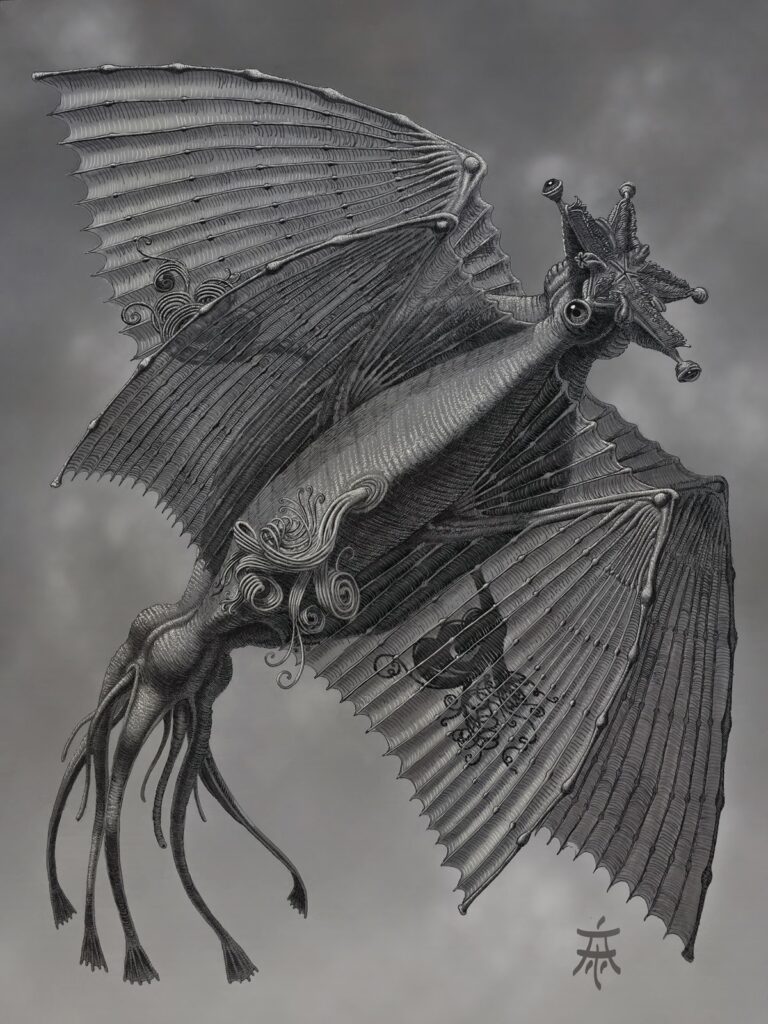
At the Mountains of Madness is Lovecraft’s Magnum opus, his most popular work after The Call of Cthulhu and without a doubt one of the best Lovecraft stories of all time.
It is another blend of science-fiction and horror that encompasses everything that makes Lovecraft so special. It’s no understatement to say it stands at the top of his entire body of work.
At the Mountains of Madness details the events that took place during an Antarctic expedition led by Dr. William Dryer of Miskatonic University.
The expedition starts off promising and the scientists discover various fossils. One of them is a strange trigonal imprint which leads Professor Lake and a part of the investigation to further investigate. Lake and his team make their way northward.
Lake and his group discover not only a giant mountain ranger higher than any other on Earth but also fourteen prehistoric lifeforms. These lifeforms are unidentifiable as either plants or animals. Six of them are damaged while eight appear to be preserved in pristine condition.
When Lake dissects one of the specimens, he realizes they bear a striking resemblance to creatures mentioned in the Necronomicon, the so-called Elder Things.
Soon after the main expedition loses contact with Lake’s group. When they stumble upon the camp, they find it destroyed. Most of the man and dogs have been slaughtered.
Near the camp, they discover six-shaped mounds, each containing one of the specimens. All the specimens in prime condition appear to have vanished and the remains of a man and a dog appear to have been dissected.
Dryer and a graduate student named Danforth, fly a plane across the mountains and discover a vast city of alien architecture. When they explore it they stumble upon hieroglyphic murals.
From there they learn that the Elder Things came to Earth shortly after the Moon was created. They built their vast city with the help of so-called Shoggoths. These are biological entities, created by the Elder Things to perform any task and assume any shape.
They continue exploring and learn that the Elder Things were in conflict with the Star-Spawn of Cthulhu and the Mi-Go. They also find hints of an unnamed evil lurking within an even larger mountain ranger beyond the city.
Their culture eventually degraded when the Shoggoths gained independence. The last of the murals become haphazard and primitive, explaining that the Elder Things eventually fled to a vast subterranean ocean.
Dyer eventually realizes that the Elder Things missing from the camp must’ve come back to life, slaughtered Lake’s group before they returned to the city.
They discover traces of the Elder Things, follow them, and are led to the entrance of a tunnel that seems to lead to the subterranean regions depicted in the murals.
There they are confronted by a black, bubbling mass which they identify as a Shoggoth. They barely escape with their lives.
As they fly back, Danforth looks back and sees something far beyond the city that destroys his sanity, implied to be the unspoken evil mentioned in the murals.
Dyer concludes that the Elder Things were merely survivors of a bygone era. They only slaughtered Lake’s group out of fear, self-defense, or scientific curiosity.
He ends the tale by warning anyone who thinks about exploring Antarctica to stay clear of the place.
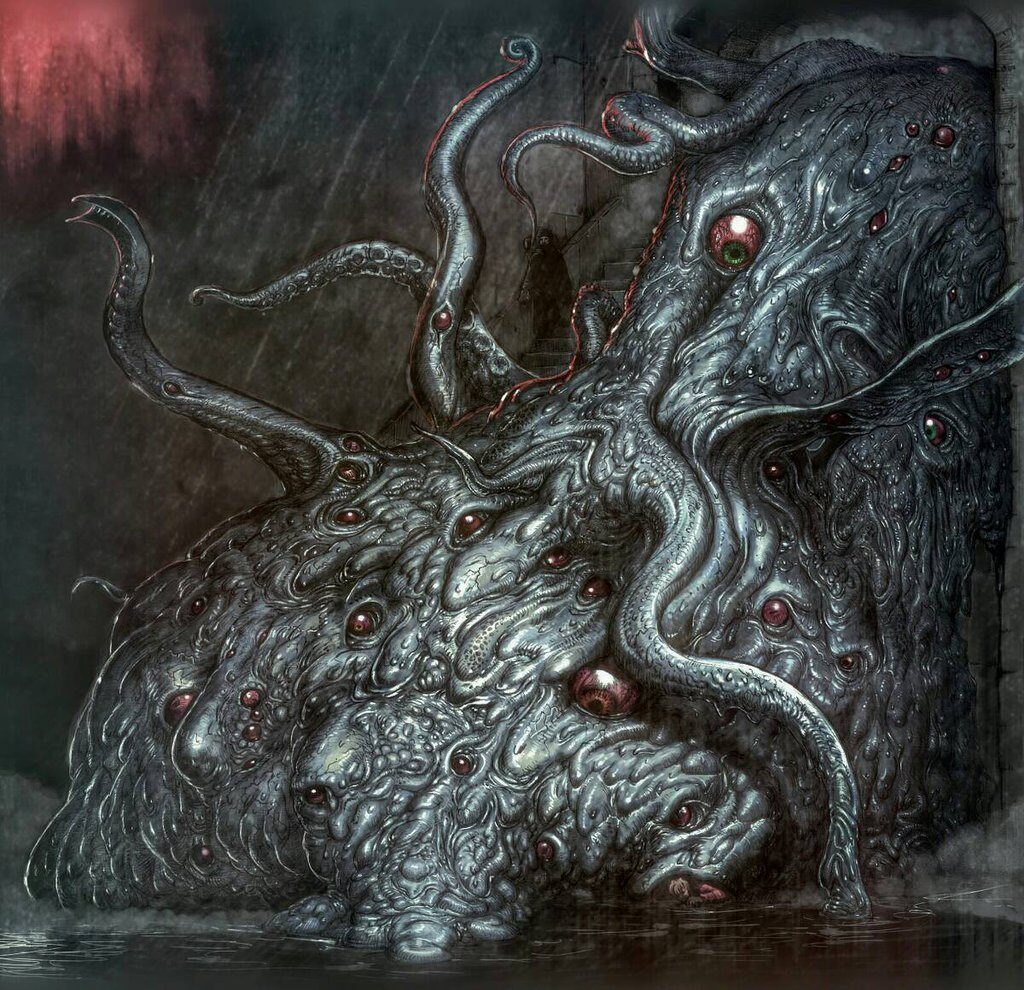
At the center of At the Mountains of Madness is a feeling of vivid dread. We are shown just how small and meaningless our place truly is. Not only in the grander scale of things, but even here, on our very own planet. He conveys this feeling by rendering vivid descriptions of icy wastes, dark artifacts, and the remnants of a lost civilization that existed long before the dawn of man.
It’s another story that’s foundational to the Cthulhu Mythos. It shows us the ancient, alien history of Earth and introduces us not only to the Elder Things and the Shoggoth but also mentions a number of Great Old Ones.
If one’s familiar with the works of Edgar Allan Poe and his novel The Narrative of Arthur Gordon Plym of Nantucket, one can find many similarities between both works. In a way, At the Mountains of Madness is an homage to Poe’s work. They both feature an Antarctic expedition and Lovecraft cites Poe’s novel twice. He even borrows the cry ‘Tekel-li’ from Poe’s work.
Lovecraft chose Antarctica as a setting not only as an homage to Poe. Even during his lifetime, there was very little known about the continent. That’s why it was the ideal spot for fictional geography and alien ruins.
At the Mountains of Madness is a fantastic, well-written tale. It comes in Lovecraft’s usual descriptive style and presents to us not only an alien landscape but also disturbingly alien creatures.
One can also see Lovecraft’s general development as a writer. In earlier stories, creatures and entities were often described as beyond explaining, or too terrifying and alien to comprehend. In At the Mountains of Madness, Lovecraft could finally present us with a clear vision of his creatures, both the Elder Things and the Shoggoths.
It’s truly one of the best Lovecraft stories, a masterpiece, and one of the greatest classics of cosmic horror and the Cthulhu Mythos.
1. The Shadow Out of Time
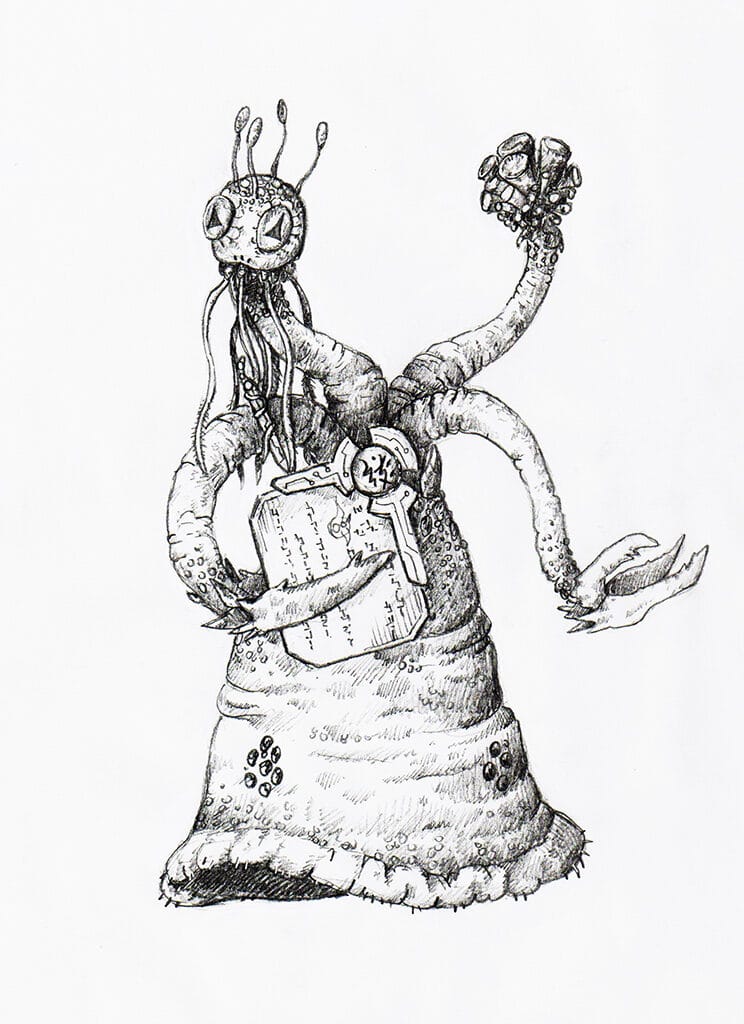
And so we finally come to The Shadow Out of Time, my favorite tale by H. P. Lovecraft.
It’s yet another blend of science-fiction and horror, but in scope, it’s by far his most epic and ambitious work.
The Shadow Out of Time introduces us to another unique creation of Lovecraft, the Great Race of Yith. They are an extraterrestrial species able to travel through time and space by switching bodies with hosts from a chosen place in time and space.
The story is told from the perspective of Nathaniel Wingate Peaslee, an American professor of political economy at Miskatonic University.
One day he suffers an attack during one of his lectures which renders him unconscious. When he finally comes to himself, five years have passed. He learns that he wasn’t in a coma, but was a changed person and had supposedly gone mad.
After he comes back to himself, his sleep is haunted by strange dreams of another world and vast, alien cities. In this city, he’s led about by strange creatures and experiences their way of life.
At first, he regards those episodes as nothing but a by-product of his temporary insanity. However, he soon comes to a different conclusion.
While he’s at first relieved to learn of other cases of similar temporary insanity, he gets worried when he learns that the experiences of others are almost identical to his.
The narrator’s dreams become more and more vivid and he becomes obsessed with archeology and ancient manuscripts. Yet, he still lacks proof for what he thinks might have happened to him.
Eventually, he leads an expedition to the Great Desert in Australia. There the ruins of a vast, ancient civilization are unearthed and within he finds proof that his dreams are indeed real.
For five years he swapped bodies with a member of the Great Race of Yith. What he finds in the ancient, million-year-old ruins are none other than his very own writings, in the English language, and written by his own hand.
I absolutely love The Shadow Out of Time, and two things make this story very special.
First, it’s the way the story is written. The Shadow Out of Time is not a simple, straightforward story. It’s written in an investigative, backward fashion as the narrator tries to uncover what happened in the past five years of his life.
And slowly, via dreams, research, and tales from acquaintances as well as family, he uncovers what truly happened.
Second, it’s the sheer scope of the narrative. It features not only people from various points in history, including ancient Romans, monks, and future wizards but also non-human entities such as Elder Things.
There’s no other story in Lovecraft’s body of work that better outlines the shallowness and pointlessness of humanity in the face of greater cosmic powers. It’s without a doubt Lovecraft’s most grandiose, most-awe-inspiring, and imaginative story. The Shadow Out of Time is Lovecraft’s purest vision of what cosmic horror is all about.
It contains nothing short of the history of the planet Earth from the eyes of both humans, but also those of a space-and-time traveling civilization that’s around way longer than we will ever be. Humanity on the other end is nothing but a footnote in the history of our very own planet. In the universe’s history, we’re unlikely to be remembered by anyone.
What’s even more interesting is the depiction of the Great Race of Yith. The Yithian’s aren’t presented antagonistically. They are benevolent to their visitors, letting them explore their vast library city and learn whatever they wish to learn.
Their entire reason for doing what they do is not to harm, but to learn. Their goal is to study all forms of civilization throughout space-and-time.
The Shadow out of time is an absolute masterpiece with a scope that’s mind-blowing. It’s not only showing us that other races inhabit Earth, an idea Lovecraft already explored in At the Mountains of Madness. No, he goes far beyond it and presents to us a race who’s able to travel not only through space but also time.
It shows us not just how vast Lovecraft’s universe is, but also how vast his imagination and creativity was.
If you want to witness Lovecraft at his grandest, at his most ambitious, I urge you to read The Shadow Out of Time. It’s a fantastic, well-written story that’s mind-blowing, both in scope and in creativity. A fantastic fit for the top spot of this list of the best Lovecraft stories.






What aspects of Lovecraft’s writing style make his stories so enduringly popular and influential in the horror genre? How does his use of language, atmosphere, and cosmic horror set him apart from other writers in the genre?”,
“refusal